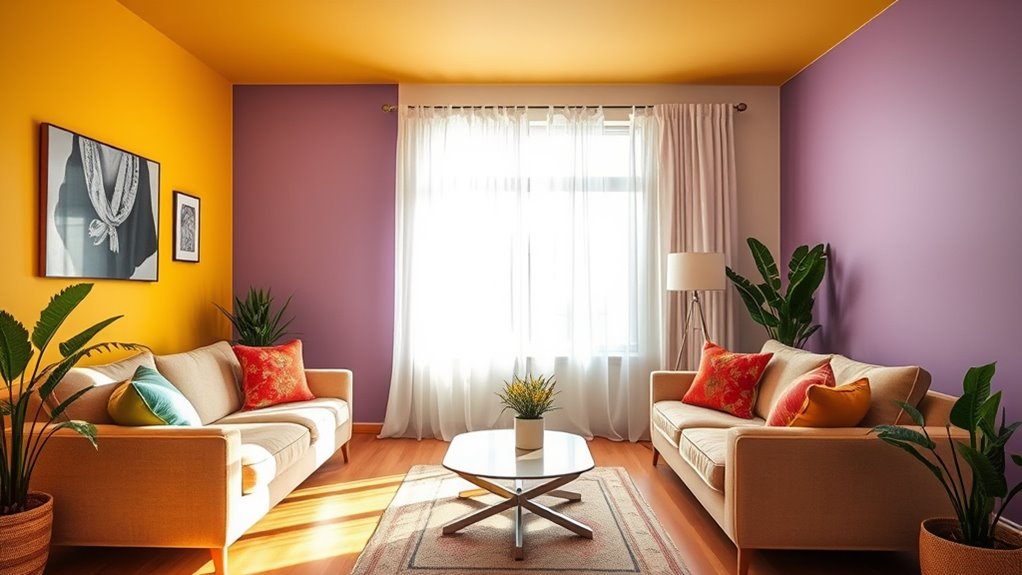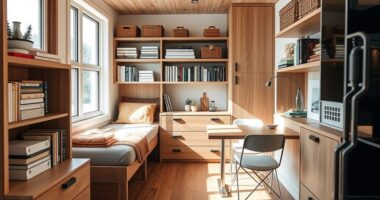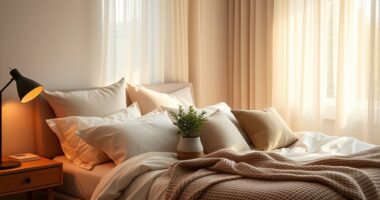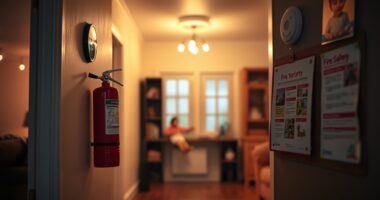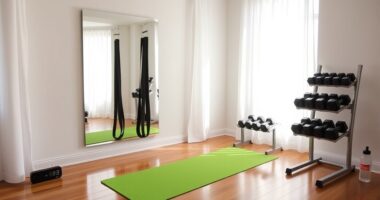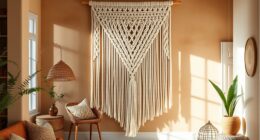Choosing wall colors carefully can boost your mood and support your well-being at home. Colors like blue bring calm and peace, while green helps you feel balanced and focused. Yellow energizes and encourages optimism, but too much may feel overwhelming. Neutrals offer a versatile backdrop that’s easy to adjust for different emotional needs. By understanding color psychology, you can create spaces that foster relaxation, motivation, or clarity—discover how to skillfully design your environment for a better mood.
Key Takeaways
- Wall colors influence emotional well-being by promoting calmness, energy, or focus based on their psychological effects.
- Blue walls create a tranquil environment, ideal for relaxation and reducing stress at home.
- Yellow walls boost energy and optimism, enhancing moods in creative or social spaces.
- Neutral tones like beige or gray provide a balanced backdrop, supporting mood flexibility and comfort.
- Strategic color choices in wall hues can foster desired emotional states, improving overall mental health at home.
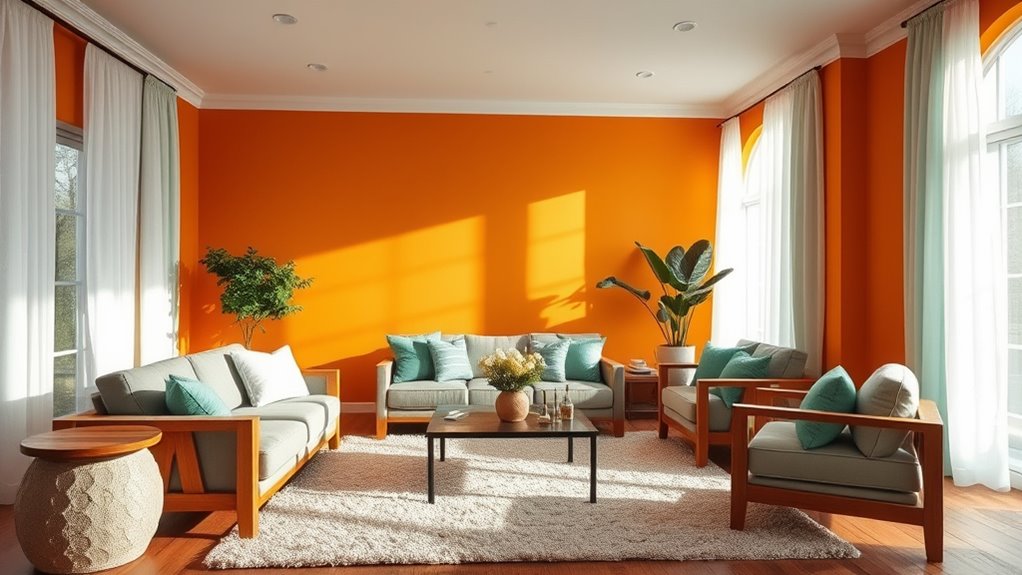
Colors in your home do more than just look good—they influence your mood and behavior. The hues you choose for your walls can subtly shape how you feel throughout the day, impacting your overall well-being. Understanding the psychological effects of different colors helps you create spaces that promote calmness, energy, or focus, depending on your needs. When you pay attention to color coordination, you ensure that your environment supports your desired emotional state, making your home a true sanctuary. Additionally, being aware of color symbolism can help you select hues that align with your intentions for each space.
Colors influence mood and behavior, shaping your emotional well-being through thoughtful coordination in your home.
For example, blue is often associated with tranquility and can bring a sense of peace to bedrooms or quiet corners. Its calming psychological effects help reduce stress and promote relaxation, making it easier to unwind after a busy day. If you want a space that encourages concentration and clarity, shades of green serve well—they’re soothing and can increase feelings of balance and harmony. Green’s connection to nature also enhances a sense of freshness and renewal, which can elevate your mood over time.
Yellow, on the other hand, is known for boosting energy and optimism. Bright yellow walls can energize a kitchen or creative workspace, inspiring positivity and enthusiasm. However, too much yellow in a small space might feel overwhelming, so balancing it with neutral tones through careful color coordination is key. Red stimulates excitement and passion, but it can also increase feelings of agitation if overused. Use it sparingly in areas where you want to evoke warmth or motivation, always considering how it interacts with other colors in the room.
Neutral colors like beige, gray, or white are versatile choices that set the stage for flexible color coordination. They provide a calming backdrop that allows other accents or furniture to stand out while maintaining a balanced atmosphere. This neutrality helps you adjust the mood easily by adding colorful accessories or art, giving you control over the psychological effects in each space.
Ultimately, the key to harnessing color psychology at home is intentionality. Select hues that align with your emotional goals and ensure they work together harmoniously through thoughtful color coordination. When you do this, you create environments that support your mental health, productivity, and relaxation. By understanding how different colors influence your psychological effects, you empower yourself to design a home that truly nurtures your well-being.
Frequently Asked Questions
Can Color Choices Influence Productivity in Home Offices?
Your color preferences and the symbolism behind different hues can substantially influence your productivity in a home office. Bright, energizing colors like yellow and orange boost motivation, while calming shades like blue promote focus. Choosing colors aligned with your personal preferences and understanding their symbolism helps create an environment that enhances your efficiency. By intentionally selecting wall colors, you can foster a workspace that keeps you motivated and productive throughout the day.
How Does Wall Color Impact Sleep Quality in Bedrooms?
Imagine it’s the 1800s, and you’re in a Victorian bedroom. Your wall color can notably impact your sleep patterns, as calming effects from soft, muted tones promote relaxation and better rest. Cool shades like blues and greens are ideal, creating a tranquil environment that supports restful sleep. So, selecting the right wall color directly influences your sleep quality, helping you wake refreshed and ready for the day.
Do Cultural Differences Affect Color Psychology Preferences?
You might notice that cultural differences influence color psychology preferences, as cultural color symbolism varies worldwide. Regional color preferences are shaped by traditions, beliefs, and history, affecting how you perceive certain colors. For example, red symbolizes luck in some cultures but danger in others. Recognizing these differences helps you choose wall colors that resonate personally and culturally, creating a space that feels harmonious and meaningful to you.
Can Changing Wall Colors Improve Mental Health?
Did you know that nearly 60% of people report improved mood after changing their wall colors? This highlights how color therapy can positively influence your emotional response. By choosing calming or uplifting shades, you can create a space that promotes mental well-being. Changing wall colors isn’t just aesthetic; it’s a simple, effective way to support your mental health and foster a more positive environment at home.
Are There Colors That Universally Promote Relaxation at Home?
You’re wondering if certain colors universally promote relaxation at home. Based on color symbolism and emotional impact, soft blues and greens are widely recognized for calming effects, reducing stress and anxiety. These hues evoke tranquility and balance, creating a peaceful environment. While individual preferences vary, incorporating these colors into your space can foster relaxation and improve overall well-being, making your home a soothing retreat.
Conclusion
So, next time you pick a wall color, remember it’s not just about style—it’s secretly shaping your mood. Ironically, the color you chose to boost your happiness might just make you feel more anxious or overwhelmed. But hey, at least you’ll have a fun story to tell about how that bold red wall was “intentionally” meant to energize you—when really, it just kept you awake all night. Who knew your home’s hue had such power?
